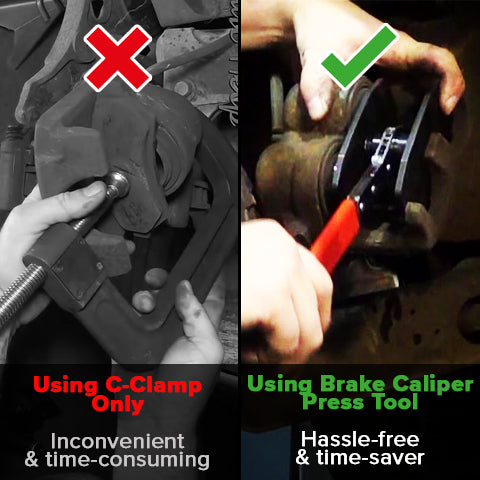Maintaining your vehicle’s brakes is crucial for safe driving. One effective way to ensure proper brake maintenance is by using a brake caliper tool. It helps in compressing the caliper piston when replacing brake pads or rotors, enabling smooth and efficient brake service.
Whether you are a DIY enthusiast or a professional mechanic, learning to use this tool can make the brake replacement process much more convenient and hassle-free.
We’ll provide an easy-to-follow guide on how to use a brake caliper tool effectively, and why it’s an essential addition to your automotive tool collection.
How To Use Disc Brake Caliper Tool Set
To use a disc brake caliper tool set, start by removing the wheel and then the caliper bolts. Use the tool to compress the caliper piston, making it easier to install new brake pads. Once the pads are in place, reassemble the caliper and wheel, and ensure everything is secure before testing the brakes.
Upon acquiring a disc brake caliper tool set, the next step is to comprehend how to use it effectively.
This handy tool is designed to assist in servicing and maintaining your vehicle’s brakes, ensuring optimal performance and safety. Below are the steps to accomplish this task:
Preparation For Brake Caliper Tool Use
- Begin by gathering all required materials and tools, including the disc brake caliper tool set, safety gloves, and eye protection.
- Before commencing any work, ensure the vehicle is parked on a level surface and the emergency brake is engaged.
- Lift the vehicle using a jack and securely support it with jack stands for additional safety.
Using The Disc Brake Caliper Tool
- Firstly, remove the caliper by loosening the retaining bolts or pins using the appropriate hand tools. Then, carefully place the caliper aside, ensuring it does not hang from the brake hose.
- Once the caliper is removed, use the disc brake caliper tool set to compress the caliper piston. Begin by selecting the correct adapter that fits the piston securely.
- Attach the disc brake caliper tool to the caliper piston and adjust it to ensure a snug fit, preventing any slippage during compression.
- Slowly turn the handle of the caliper tool in a clockwise direction, gradually compressing the piston back into the caliper bore. Be watchful for any resistance, ensuring the piston compresses smoothly and evenly.
- After successfully compressing the piston, carefully remove the caliper tool and proceed with the necessary brake maintenance or replacement.
- Once the maintenance is completed, carefully reassemble the caliper and ensure all components are properly secured.
By following these steps, you can effectively utilize a disc brake caliper tool set to maintain and service your vehicle’s brakes, ensuring safety and optimum performance.

Credit: bestcargurus.com
Frequently Asked Questions On How To Use A Brake Caliper Tool
What Is A Brake Caliper Tool Used For?
A brake caliper tool is used to retract the piston in the brake caliper, making it easier to install new brake pads. It helps prevent damage to the caliper and allows for smooth brake maintenance.
How Do I Use A Brake Caliper Tool?
To use a brake caliper tool, secure the tool to the caliper and turn the handle to retract the piston. Ensure it’s compatible with your specific caliper type for effective and safe operation. Follow the manufacturer’s instructions for best results.
What Are The Different Types Of Brake Caliper Tools?
There are various brake caliper tools available, including cube tools, ratchet tools, and wind-back tools. Each type is designed for specific caliper designs and applications, so choose the right tool for your vehicle’s caliper system.
Conclusion
Learning how to use a brake caliper tool is crucial for DIY car maintenance. By following the steps mentioned in this blog post, you can effectively and safely use the tool to maintain your vehicle’s brakes. Regular maintenance ensures optimal performance and safety on the road.
Mastering this skill will save you time and money in the long run. Keep these tips in mind and always prioritize safety when working on your vehicle.
